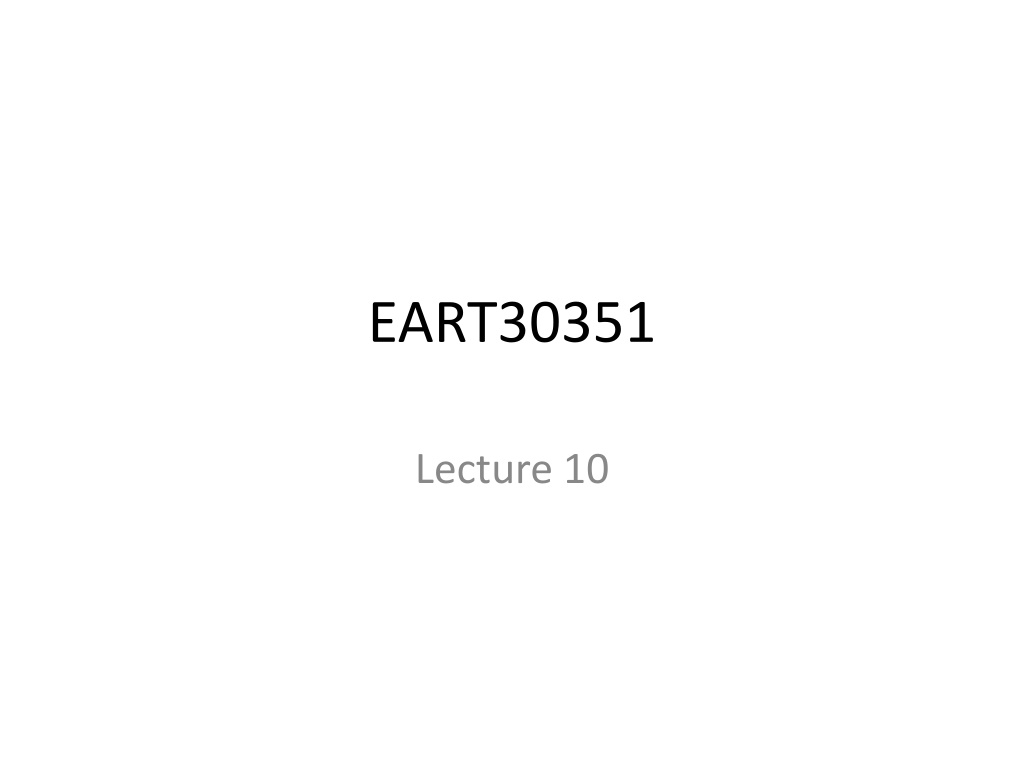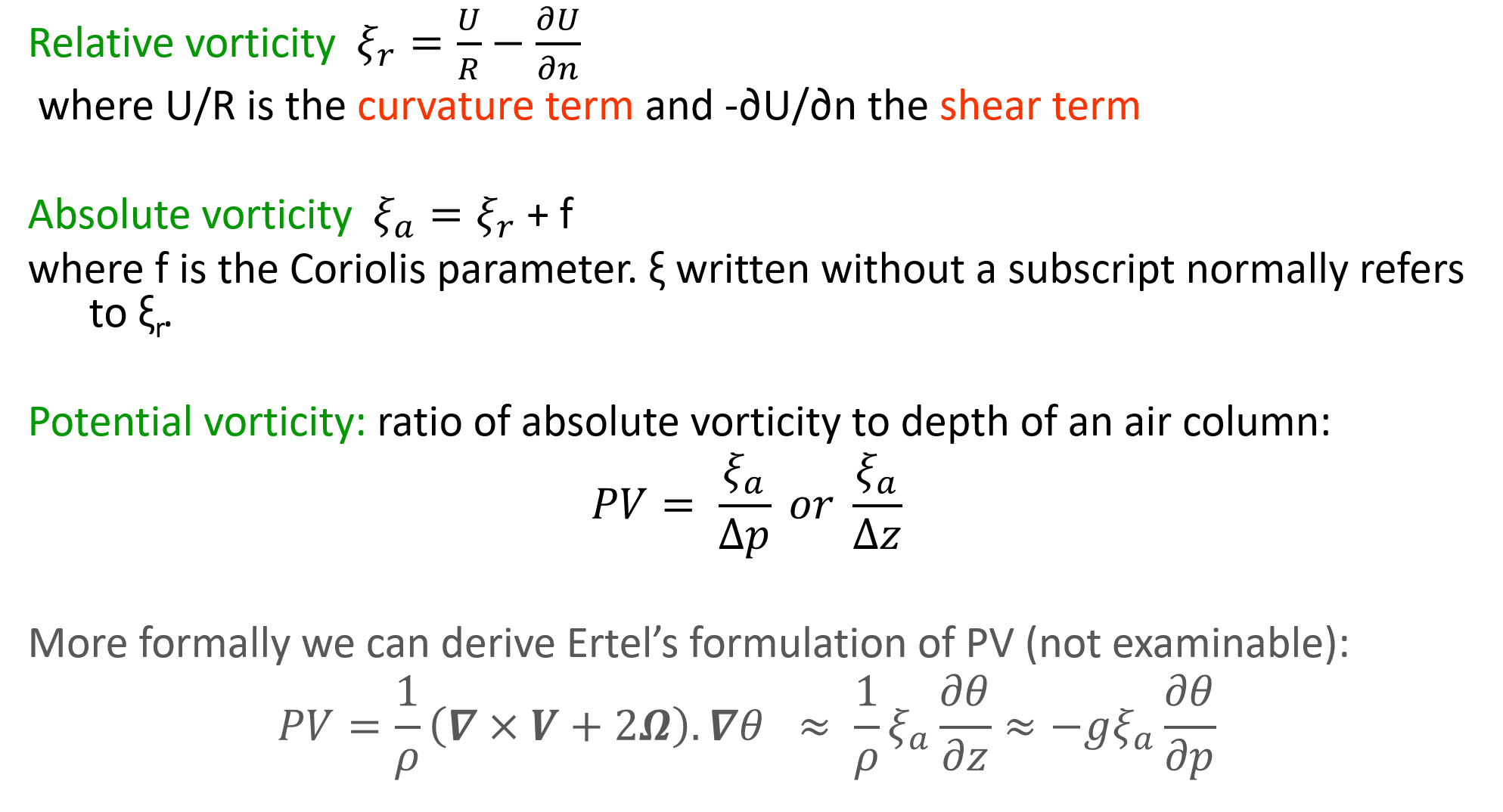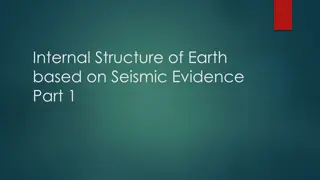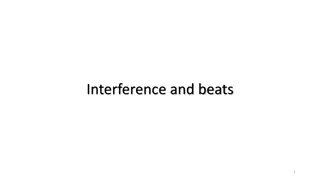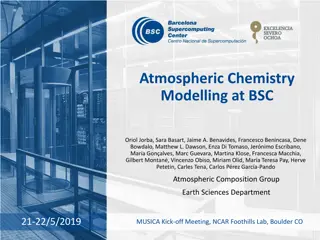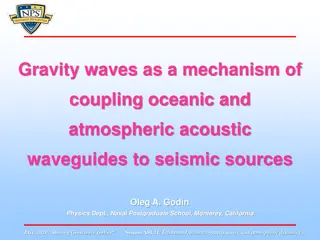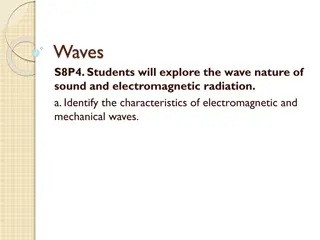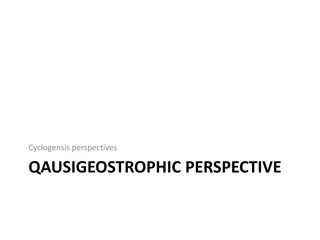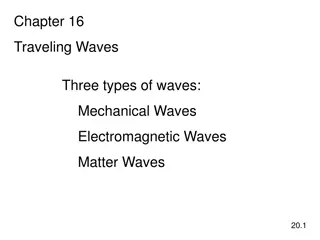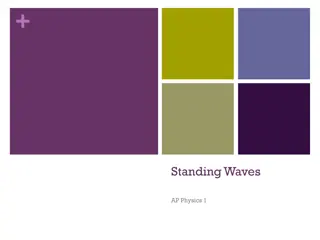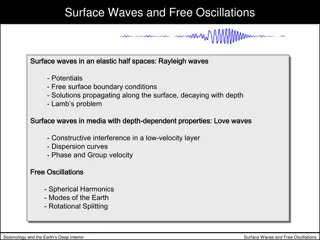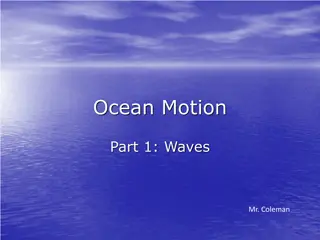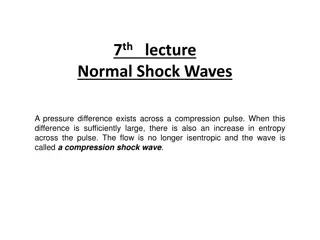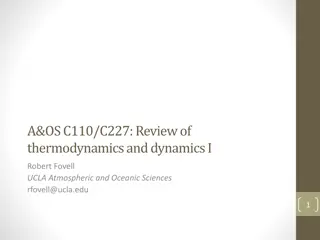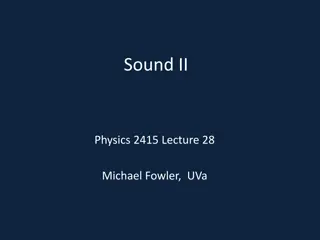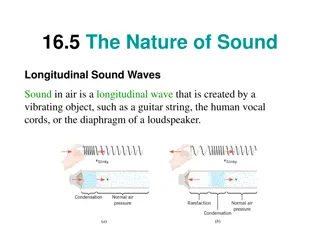Atmospheric Dynamics: Vorticity, Rossby Waves, and Conservation of PV
Exploring key concepts in atmospheric dynamics such as relative vorticity, absolute vorticity, Rossby waves, and conservation of potential vorticity. Topics include the exchange of relative and planetary vorticity, implications of vorticity changes on airflow patterns, and the role of PV in understanding tropopause dynamics. This discussion delves into mathematical principles and practical applications related to jet streams and convergence patterns around jet streaks.
Download Presentation

Please find below an Image/Link to download the presentation.
The content on the website is provided AS IS for your information and personal use only. It may not be sold, licensed, or shared on other websites without obtaining consent from the author. Download presentation by click this link. If you encounter any issues during the download, it is possible that the publisher has removed the file from their server.
E N D
Presentation Transcript
EART30351 Lecture 10
Reminder Relative vorticity ??=? where U/R is the curvature term and - U/ n the shear term ? ?? ?? Absolute vorticity ??= ??+ f where f is the Coriolis parameter. written without a subscript normally refers to r. Potential vorticity: ratio of absolute vorticity to depth of an air column: ?? ????? ?? = ? More formally we can derive Ertel s formulation of PV (not examinable): ?? =1 ?? ? + 2? .?? 1 ??? ?? ?? ??? ?? ??
Rossby waves Basic mechanism is exchange of relative and planetary vorticity A r <0 Increasing B r >0 Increasing f = 2 sin Dines compensation involves C-D dipoles. In the mid-troposphere there is a level of non-divergence. By the barotropic vorticity equation, +f is conserved at this level. Parcel of air at A experiences increasing f so develops negative (anticyclonic) vorticity and turns clockwise. Parcel at B experiences the reverse. So we get undulating flow in the westerlies.
Simple mathematical ideas Consider a non-divergent level in the mid-troposphere ? ?? ??+ ? = 0 See Rossby_waves.doc for derivation of dispersion equation (not examinable). Wave phase speed c = U / 2, where = wavenumber and = f/ y = 2 cos /A. At 60 N, =1.1 x 10-11 s-1 m-1 Short wavelength (large ) waves travel eastward, long wavelength waves (small ) travel westward. For c=0 (stationary waves), 2 = /U, giving 6x10-7 m-1 or wavelength 104 km using U 30 ms-1. Unfortunately this approach only captures some of the properties of Rossby waves for a more rigorous treatment we must turn to quasi-geostrophic theory which is beyond an introductory course.
C and D at jet stream level a vorticity-based view Complements the approach using ageostrophic winds 1. Level of non-divergence is mid-tropospheric. Increasing +f f = y y ? =? ? ?? ?? 2. Wind (U) is stronger in upper troposphere so is larger. 3. Amplitude doesn t change with height so f remains the same. 4. So, absolute vorticity is a minimum in a ridge and maximum in a trough
Conservation of PV Tropopause + f increases ?? ? ?? = p Increase in absolute vorticity means increase in p and therefore downward motion (since 0 in the stratosphere).
Convergence around jet streak Undisturbed background flow ?? ??<< 0 C ?? ??< 0 ?? ??< 0 D Jet C ?? ??> 0 D ?? ??> 0 ?? ?? 0 Undisturbed background flow As the flow accelerates into the jet streak, the wind shear either side of the jet tightens (| U/ n| increases in magnitude). This forces convergence and divergence patterns as we saw previously.
Convergence around Rossby wave A Divergence +f increases C B r < 0 +f decreases Convergence r > 0 As air flows from A to B the absolute vorticity increases, so the air parcels stretch downward motion. Air flowing from B to C shrinks upward motion. Upward motion in the troposphere promotes deep convection and cyclones Downward motion in the troposphere promotes clear skies and anticyclones
Example 1 Upper tropospheric air flows at a speed of 30 ms-1 through a sinusoidal trough-ridge pattern at 50oN, of peak-to-peak amplitude 500 km and wavelength 3000 km. Calculate the change in absolute vorticity between ridge and trough, and derive the fractional change in the depth of an air column as it traverses the pattern. (The radius of curvature of y = a sin(kx) is (ak2)-1 at the crests).
A a =250 km 30 ms-1 500 km = 3000 km; k=2 / B First, calculate Radius of curvature R at crests (A and B) Amplitude a = 250 km, =3x106 m so k = 2.09x10-6 m-1 ak2 = 1.09 x 10-6 m-1 so R =916 km U/R= 3.28 x 10-5 s-1 (+ve in trough, -ve in ridge)
U U = + 1. Absolute vorticity a f - R n a = 2. Potential vorticity const p use 1, with no shear vorticity term (uniform speed). 250 km corr. to 2.25 lat (1 = 111 km) ftrough (47.75 ) = 1.08 10-4 s-1 so a=1.41 10-4 s-1 fridge (52.25 ) = 1.15 10-4 s-1 so a = 0.82 10-4 s-1 Fractional change in depth of air column is calculated using 2. In the straight part of the flow, a= f = 1.12 10-4 s-1. Since PV is conserved: . p straight a, straight p 1.409 = = 1.26 = trough trough a, 1.12 p 0.821 = = 0.73 = ridge ridge a, p 1.12 straight straight a,
Example 2 A zonal jet streak develops in a uniform zonal flow of 30 m s-1 at 60 N. The jet has a maximum speed of 80 m s-1. The cyclonic side is 200 km wide and the anticyclonic side 600 km wide. If the initial depth of a column of air which enters the jet is 100 mb, use the barotropic vorticity equation to estimate its depth at maximum velocity if it is positioned: (i) poleward of the jet core (ii) equatorward of the jet core (iii) directly upstream of the jet core. What limits the accuracy of these estimates?
30 ms-1 30 ms-1 30 ms-1 200 km (i) 30 ms-1 30 ms-1 80 ms-1 J 600 km (ii) 30 ms-1 30 ms-1 30 ms-1 (i) Shear vorticity = - U/ n = (80-30)/(200x103) = 2.5x10-4 s-1 f = 1.26x10-4 s-1 so absolute vorticity = 3.76 x 10-4 s-1 Applying conservation of PV = a / p so p at (i) is (3.76/1.26)*100 = 298 mb
30 ms-1 30 ms-1 30 ms-1 200 km (i) 30 ms-1 30 ms-1 80 ms-1 J 600 km (ii) 30 ms-1 30 ms-1 30 ms-1 (i) Shear vorticity = - U/ n = (80-30)/(200x103) = 2.5x10-4 s-1 f = 1.26x10-4 s-1 so absolute vorticity = 3.76 x 10-4 s-1 Applying conservation of PV = a / p, so p at (i) is (3.76/1.26)*100 = 298 mb (ii) Shear vorticity = - U/ n = -(80-30)/(600x103) = -0.833x10-4 s-1 f = 1.26x10-4 s-1 so absolute vorticity = 0.427 x 10-4 s-1 Applying conservation of PV = a / p So p at (i) is (0.427/1.26)*100 = 34 mb
30 ms-1 30 ms-1 30 ms-1 200 km (i) 30 ms-1 30 ms-1 80 ms-1 J 600 km (ii) 30 ms-1 30 ms-1 30 ms-1 (i) Shear vorticity = - U/ n = (80-30)/(200x103) = 2.5x10-4 s-1 f = 1.26x10-4 s-1 so absolute vorticity = 3.76 x 10-4 s-1 Applying conservation of PV = a / p, so p at (i) is (3.76/1.26)*100 = 298 mb (ii) Shear vorticity = - U/ n = (80-30)/(600x103) = 0.833x10-4 s-1 f = 1.26x10-4 s-1 so absolute vorticity = 0.427 x 10-4 s-1 Applying conservation of PV = a / p, so p at (i) is (0.427/1.26)*100 = 34 mb (iii) No change in vorticity along axis of jet so no change in p
Curved jet streaks convergence/divergence C, D : due to trough or ridge; C,D : due to jet entrance/exit Confluent trough Diffluent trough Regions with DD are most favourable to growth of cyclones D C D D D D Regions CC are most favourable to growth of anti- cyclones D C C C C D C D C C Confluent ridge Diffluent ridge
